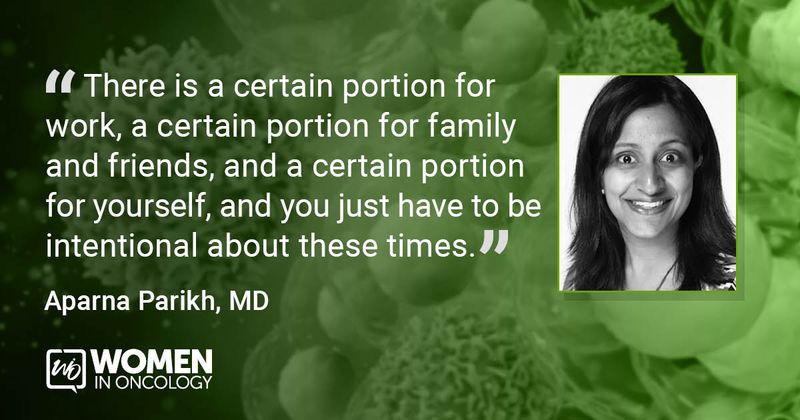Maternity leave as an oncologist characterized by guilt, need to set boundaries
When some patients with cancer may have limited life expectancies, taking time off as an oncologist can be all the more complicated.
For instance, median survival for many patients with gastrointestinal cancer with stage IV disease is about 1 year, according to Aparna Parikh, MD, an oncologist who frequently treats these cancers.

“When you take a 3-month maternity leave to recover, bond and nourish this tiny human being, this time, and its significance to patients, particularly for patients at the end of life, make even precious time like maternity complicated,” Parikh, who serves as director of the Global Cancer Care Program and medical director of the Center for Young Adult Colorectal Cancer at Massachusetts General Hospital, said in an interview with Healio.
“A 3-month maternity leave is a lot of time in that patient’s journey,” she added. “It’s hard to be a mom overall and particularly in oncology, where the relationship between a patient and their oncologist is profound, you are deeply invested in your patients and many need you for their own peace of mind, even when there is coverage in place.”
Like women in other professions, female physicians are entitled to paid maternity leave. However, the rigorous work schedules of physicians, as well as the need to keep up with clinical and academic demands, can present a balancing act that is difficult to maintain.
According to a 2019 study published in JAMA Network Open, researchers found that attending physicians in the United States took a mean of 8 weeks of paid maternity leave, whereas residents took a mean of 6 weeks. In the same cross-sectional survey of 844 physician mothers, 73% of respondents stated that they did not consider the duration of their leave to be sufficient. Additionally, the respondents reported negative experiences related to taking leave and discrimination upon returning to work.
“Work will always fill the space that you allow it to fill, and that space can be infinite,” Parikh said. “That is not the intent, but it’s just the nature of connectivity. Also, current benchmarks and deadlines of academic productivity and promotion are not necessarily changed or adjusted based on maternity leave. We are still bound by the timelines and deadlines set forth by systems. I submitted a major grant 2 days after my third child was born as there was no flexibility on the deadline.”
Connectivity and boundaries
Parikh said the double-edged sword of increased connectivity has served to blur the lines between work and home life, and this made her most recent maternity leave even more of a challenge.
“I felt like at least there were some boundaries before,” Parikh said. “COVID-19 in many ways actually made maternity leave more challenging because nobody was physically going anywhere, and it was easier for people to ask, ‘It’s OK if you have the baby with you, but can you just quickly pop on for this meeting?’ Or they might say, ‘I know you’re not checking email, and I’m so sorry to send this, but ...’. It comes in all flavors, and everyone needs to make a decision that feels comfortable and works for them.”
Parikh added that female physicians might feel uncomfortable taking extended leave if it is offered, even if this added time would benefit their family life.
“I think women, especially, tend to feel a lot of guilt,” she said. “I’m in Massachusetts, and I had the ability to take an extended leave beyond the 3 months and not get paid fully, but I could take up to 5 months. I grappled with that for a while — if this were an ideal world where that time was entirely my own for me and the baby, that would have been great. However, the connectivity factor changed that. I wasn’t entirely connected, but I was still fairly connected to work throughout my life, so extending the time just didn’t make sense.”
Additionally, Parikh said her nurse practitioner had to bear a disproportionate burden of responsibility while she was on leave, and Parikh said she felt guilty about her NP’s burden. She said although her NP did an excellent job of holding down the fort, there wasn’t a constant oncologist for her patients but rather whoever was covering on any given day.
“Perhaps, if there was a shared-practice model where you had another physician who really knew your patients well, that would have different,” she said. “In terms of the coverage, my colleagues did the best they could and provided excellent care, but it’s just different when you understand their entire journey. I had some patients who ultimately ended up not feeling comfortable with my absence and ended up transferring providers.”
In other cases, patients asked covering physicians to check with Parikh to be sure she agreed with a change in treatment plan.
“So, I was getting contacted anyway,” she said.
Parikh said she believes these situations would ideally be changed by people at the top levels of leadership where culture is often set.
“It would be great if the message came from the leadership that this is an important time, and that the expectation is that people aren’t supposed to send you emails, and here’s the coverage system for your patients,” she said. “It would be great if it were not only implicit but explicit that this is your time and that we support a culture that allows you and empowers you to have that time as that time, at least for me, came with some guilt. I think some people legitimately think maternity like is like a vacation or mini sabbatical — these people clearly have not had a newborn!”
Carving out time
Although change at the highest levels of an institution is the ideal, Parikh noted that physicians on maternity leave can find their own ways and time to bond with their new arrivals.
“We have a nanny as I had two other children and both my partner and I work full-time. I would sometimes let our nanny go home early because if I had her around, my inclination would be to just nurse and then pass off the baby to get a little work done,” she said. “But when I would let our nanny go, it was just me and this little human needed me and all of me. That protected time was so important and precious for both of us. I had a little routine — the computer would be away, I would put her in the carrier, and we just went for a long walk. I loved that time.”
Parikh stressed the value of being intentional with her time while she was on maternity leave.
“What we balance is like a Venn diagram. There is a certain portion for work, a certain portion for family and friends, and a certain portion for yourself, and you just have to be intentional about these times,” she said. “There are days and times when work might take priority — for example, when you have a sick patient or a big deadline — but other days and times when you shift the focus to family, spouse and kids. The Venn diagram is fluid and constantly changing.”
Adoption leave: ‘An adventure’
Planning for maternity leave is difficult enough when a woman has a general sense of her baby’s expected arrival. Others, like was the experience of Ashley L. Sumrall, MD, FACP, are at the mercy of a “stork drop.” This occurs when a baby available for adoption is born and parents are needed immediately, Sumrall said.
“It can be very disruptive to your professional life, your professional life and your clinic schedule,” Sumrall, who is a section chair of neuro-oncology at Atrium Health Levine Cancer Institute and an adoptive mother, said in an interview with Healio. “You are so dependent on those who are near you, your work family.”
Sumrall, who has two adopted children and two biological children, said she and her husband tried to adopt in June of 2019. At that time, Sumrall had made extensive plans for work coverage and time off, but the baby’s birth mother had a last-minute change of heart.
A more common scenario for adoptive parents is the one that occurred in the case of Sumrall’s first adoption. An oncology fellow at that time, Sumrall received a phone call about a baby who had been born in Alabama.
“They said, if you want the baby, you have to come tonight,” Sumrall said. “I had to make a decision on the spot. My biggest fear was for my career and the fate of my trainee program.”
Sumrall said although it is not always possible to prepare logistically for an adoption, it is important and necessary to be prepared psychologically and financially.
“It is expensive, no matter which way you go,” Sumrall said. “You also just have to realize that there will be chaos, and it is an adventure.”
Complicated adoptions
Sumrall said although she adopted newborns in both cases, many adoptive parents choose to adopt older children, either through overseas adoption or through the foster care system. She said these situations present more complexities than simply arranging for coverage at work.
“These families have unique needs because they are bonding when the child is older, and they need some work flexibility,” she said. “On a positive note, people seem more comfortable talking about adoption today than they have been in the past. I think adoptive parents are doing a better job of being vocal about the needs they have.”
Overseas adoptions may also involve travel, and then helping a child adapt not only to life with new parents, but in a new country. Even babies adopted through more conventional channels may present unexpected challenges, Sumrall said.
“Our newest baby had some heart issues, and we had to facilitate the scheduling of doctor’s appointments, and getting her established with medical care,” she said. “There are all these different things you have to plan, all these little pieces.”
Sumrall said she was very fortunate in that her workplace updated its adoptive benefits to include 4 weeks of paid leave.
“They instituted that just within the past year, so that was really helpful,” she said. “A lot of places are not that supportive. So, you can choose to take as long as others, but it’s hard. You can also argue that having that time off to bond with your child is even more important when you aren’t exactly related.”
Sumrall said she relied a great deal on her colleagues at work, who she credits with helping her manage her patients with some continuity.
“I have an incredible work family, and I could not have done this without them. I had two other physicians who helped, as well as a nurse practitioner, my clinic nurse and our whole team,” she said, “We just sat down and planned our strategy. We made the decision that we would tell our patients why I was out, and that I would still be involved. Because we were prepared, things went smoothly.”
She concurred with Parikh, however, regarding the difficulties of taking time off as an oncologist.
“When you’re an oncologist, your patients have very specific goals and milestones in their care,” she said. “They really want their personal physician to be with them for these milestones. It can be very difficult to bring in a new doctor or a covering physician. You have to navigate the best strategy for yourself, your practice and your patients.”
She said she turned to other physician parents, both adoptive parents and those who went through traditional childbirth, for support and encouragement.
“Above all, you have to remember that it’s worth it,” she said. “Whatever difficulties you encounter along the way, you’ll handle them — and it will be worth it.”
For more information:
Aparna Parikh, MD, MS, can be reached at aparna.parikh@mgh.harvard.edu.
Ashley L. Sumrall, MD, FACP, can be reached at ashley.sumrall@atriumhealth.org.

